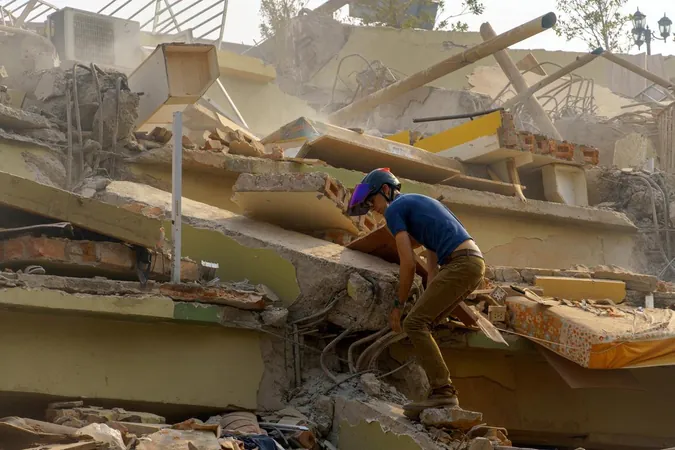
Myanmar Earthquake Catastrophe: Death Toll Climbs to 1,700 as International Aid Floods In
2025-03-30
Author: Nur
The aftermath of Myanmar's devastating earthquake, which struck on March 28, is turning into a humanitarian crisis of monumental proportions. As of March 30, the military government reported a grim toll of approximately 1,700 dead, 3,400 injured, and over 300 individuals still missing. This 7.7-magnitude quake, one of the most powerful to hit the region in a century, has left the country grappling with overwhelming devastation.
Amidst this turmoil, junta chief Min Aung Hlaing expressed fears that casualties could continue to rise, prompting an unprecedented appeal for international aid from his administration. Rescue teams from neighboring countries, including India, China, and Thailand, are converging on the crisis, alongside contributions from Singapore, Malaysia, Indonesia, and Russia.
Despite these efforts, many residents in cities such as Mandalay and Sagaing reported that aid has yet to reach them, triggering worries over a critical shortage of food, electricity, and water supplies. The International Federation of Red Cross and Red Crescent Societies highlighted the extensive destruction and escalating humanitarian needs in their statements, emphasizing the urgency of outside assistance.
The United States has pledged $2 million in aid directed towards local humanitarian organizations, deploying an emergency response team from USAid to support relief efforts. This comes at a time when Myanmar is already reeling from the chaos of a civil war sparked by the military coup that overthrew the democratically elected government led by Nobel Peace Prize laureate Aung San Suu Kyi in 2021.
Destruction of vital infrastructure—bridges, highways, and hospitals—intensifies the obstacles facing rescue operations. Reports indicate that hospitals in central and northwestern Myanmar are overwhelmed, with medical facilities struggling to handle the influx of injured victims.
Eyewitness accounts reveal a grim reality. A Mandalay monk reported that unsafe buildings have forced people into the streets as they lack adequate shelter. Some hospitals have collapsed, leaving patients without beds or proper care. Local self-help groups are providing food and water due to the absence of international support.
International rescue efforts are ongoing, with Chinese teams successfully freeing a woman trapped for 60 hours in a collapsed hotel in Mandalay. Notably, the Indian military has mobilized aircraft to deliver supplies and set up emergency field hospitals. An 80-member Singaporean team, including rescue dogs, is also on the ground, searching for survivors in the devastated capital.
In neighboring Thailand, the quake's impact was felt as well, resulting in the collapse of a high-rise building in Bangkok that killed 18 people. Rescuers continue to work tirelessly, utilizing drones and sniffer dogs to locate those trapped in the debris.
Promisingly, Myanmar’s opposition National Unity Government has announced a temporary ceasefire in offensive actions from March 30 to aid in the rescue and recovery efforts. However, in areas near the quake’s epicenter like Sagaing, the reality remains dire, with reports of widespread destruction and a complete lack of aid.
Satellite imagery reveals the collapse of critical bridges, which hampers the delivery of supplies even from nearby Mandalay. Residents, feeling abandoned, voiced their despair, stating they have received no aid or rescue personnel. The humanitarian situation is rapidly deteriorating, as many areas remain isolated and in desperate need of help.
In Mandalay, rescue teams are faced with an agonizing task—many individuals are feared trapped under rubble, requiring heavy machinery for extraction. With limited resources, rescuers are trying their best to save lives using basic tools. Meanwhile, heartbreaking scenes unfold in Bangkok as relatives wait anxiously for news of their loved ones still trapped beneath the ruins.
As the situation develops, the world watches closely, hoping for a rapid response to alleviate this escalating humanitarian disaster. The need for international cooperation and support is clearer than ever, as Myanmar faces a dual crisis of disaster recovery and political unrest.




 Brasil (PT)
Brasil (PT)
 Canada (EN)
Canada (EN)
 Chile (ES)
Chile (ES)
 Česko (CS)
Česko (CS)
 대한민국 (KO)
대한민국 (KO)
 España (ES)
España (ES)
 France (FR)
France (FR)
 Hong Kong (EN)
Hong Kong (EN)
 Italia (IT)
Italia (IT)
 日本 (JA)
日本 (JA)
 Magyarország (HU)
Magyarország (HU)
 Norge (NO)
Norge (NO)
 Polska (PL)
Polska (PL)
 Schweiz (DE)
Schweiz (DE)
 Singapore (EN)
Singapore (EN)
 Sverige (SV)
Sverige (SV)
 Suomi (FI)
Suomi (FI)
 Türkiye (TR)
Türkiye (TR)
 الإمارات العربية المتحدة (AR)
الإمارات العربية المتحدة (AR)